We had a large group to go through Pompeii today. Mt Vesuvius erupted in 70AD and completely buried the city of Pompeii, which is a completely unique time capsule that shows what live was like in the first century. Pompeii was totally buried beneath a rain of ash and volcanic material as Mt Vesuvius erupted, leaving the entire city frozen in time and a huge amount of information about ancient Roman life has been found here.

Before the eruption, Pompeii was known as a vacation getaway resort town, that also had a strong commercial port focus. But after the 79AD eruption, it remained buried until 1700 years later. Lots of ancient shops and streets are remarkably well preserved, along with vivid frescoes and striking plater casts of the remains of people died, caught by the swift volcanic ash. The amphitheater of Pompeii was primarily used for musical productions. With excellent acoustics, this theatre held about 2000 people.
The amphitheater of Pompeii was primarily used for musical productions. With excellent acoustics, this theatre held about 2000 people.


On any of the main thoroughfares through Pompeii, you can find commercial trading site, shops, shops and more shops. This store has a marker on the sidewalk that tells people that food is available here. Many Pompeians would be out their entire day and would not return home for their midday meals, so they would stop by, what were effectively, fast food vendors to grab quick lunches.
 Pots where food would be stored and kept warm to sell to workers and passers-by.
Pots where food would be stored and kept warm to sell to workers and passers-by. Walled edge of the amphitheatre directly opposite the ‘fast food’ store.
Walled edge of the amphitheatre directly opposite the ‘fast food’ store. Typical Roman house. This house however had a few more bits of information that tells us something about its inhabitants. The large plinth doorway tells us the inhabitants were quite well off. The seats outside the house tell us that this is apparently a politicians house – people would come to meet and air their grievances and concerns with the local politician and would wait their turn in the street.
Typical Roman house. This house however had a few more bits of information that tells us something about its inhabitants. The large plinth doorway tells us the inhabitants were quite well off. The seats outside the house tell us that this is apparently a politicians house – people would come to meet and air their grievances and concerns with the local politician and would wait their turn in the street. Further evidencing this as the home of a politician was this little piece of propaganda. As it turns out, Pompeii was in the middle of an election period when the volcano erupted, and a good deal of electoral propaganda can be found on the walls. This sign is telling citizens to vote for “Cornelivm”, the man who owns the house above.
Further evidencing this as the home of a politician was this little piece of propaganda. As it turns out, Pompeii was in the middle of an election period when the volcano erupted, and a good deal of electoral propaganda can be found on the walls. This sign is telling citizens to vote for “Cornelivm”, the man who owns the house above.  A little further down the street is the House of Menandro. This is a very well preserved example of a wealthy Roman’s home. The entry foyer/lobby has the typical water feature and open roof, designed to create a type of evaporative cooling system, and to catch water from the opening in the roof for a pretty indoor water feature. Off this room would be all the bedrooms for the inhabitants of the house.
A little further down the street is the House of Menandro. This is a very well preserved example of a wealthy Roman’s home. The entry foyer/lobby has the typical water feature and open roof, designed to create a type of evaporative cooling system, and to catch water from the opening in the roof for a pretty indoor water feature. Off this room would be all the bedrooms for the inhabitants of the house. The frescos are just remarkable – nearly 2000 years old and still quite vivid. Pompeian Red is a thing because of these frescos. The blue colour is apparently the most expensive colour to paint your wall with as it was made with ground lapis.
The frescos are just remarkable – nearly 2000 years old and still quite vivid. Pompeian Red is a thing because of these frescos. The blue colour is apparently the most expensive colour to paint your wall with as it was made with ground lapis. The detail is beautiful – it makes me feel we have lost something in the art of interior decor in the modern era…
The detail is beautiful – it makes me feel we have lost something in the art of interior decor in the modern era…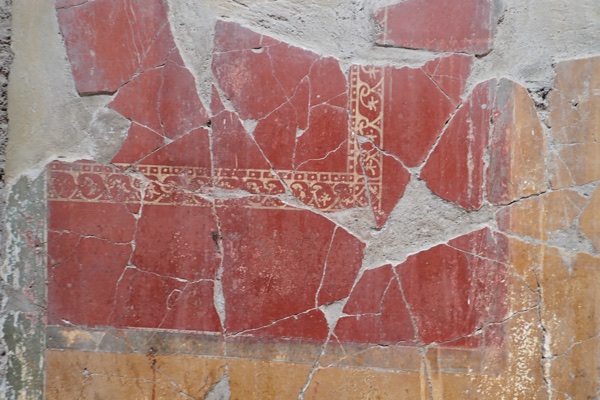 Further through the house are rooms that would have been used for business, for entertaining, for visitors, for cooking, slave quarters – an entire complex to house a Roman household.
Further through the house are rooms that would have been used for business, for entertaining, for visitors, for cooking, slave quarters – an entire complex to house a Roman household. The central garden courtyard is further back in the house, behind the central fountained lobby and bedrooms.
The central garden courtyard is further back in the house, behind the central fountained lobby and bedrooms.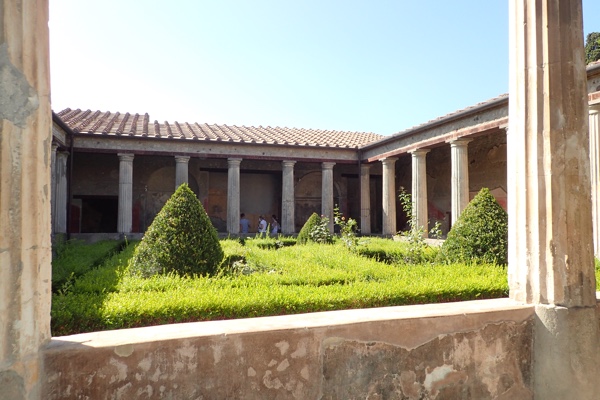
 Most Roman homes did not have a private bathhouse, but this home did. It has a small frigidarium and tepidarium for the wealthy nobles who lived here.
Most Roman homes did not have a private bathhouse, but this home did. It has a small frigidarium and tepidarium for the wealthy nobles who lived here.
 Bathhouse.
Bathhouse.  I am certain this house is not the only example, but the owners of this house fled the volcano – whether they survived or not is unknown… what is known is that they locked all their wealth and goods into rooms with their slaves to protect them. The slaves in their desperation smashed down the walls in an attempt to escape, but were likely too late to get away. Ash rained down on Pompeii for two days, but the people here had no idea what was happening or how long it would last. At the end of it, the entire city was covered and considered lost.
I am certain this house is not the only example, but the owners of this house fled the volcano – whether they survived or not is unknown… what is known is that they locked all their wealth and goods into rooms with their slaves to protect them. The slaves in their desperation smashed down the walls in an attempt to escape, but were likely too late to get away. Ash rained down on Pompeii for two days, but the people here had no idea what was happening or how long it would last. At the end of it, the entire city was covered and considered lost.

 We went for a walk up the top of a small hill to have a view over the city. Here we got to see the winding streets and how tightly packed the city was.
We went for a walk up the top of a small hill to have a view over the city. Here we got to see the winding streets and how tightly packed the city was.
 The view down over the streets was from an elevated position, which we later found out is an un-excavated part of the city. We were standing on top of more ancient Roman ruins that it has been decided to leave buried for future generations. You see, due to Mt Vesuvius’ close proximity comes an awareness that it will erupt again one day. And everything that has been excavated could be destroyed. Again. So they have left a large section sealed as it were for after that eventuation.
The view down over the streets was from an elevated position, which we later found out is an un-excavated part of the city. We were standing on top of more ancient Roman ruins that it has been decided to leave buried for future generations. You see, due to Mt Vesuvius’ close proximity comes an awareness that it will erupt again one day. And everything that has been excavated could be destroyed. Again. So they have left a large section sealed as it were for after that eventuation.
Mt Vesuvius (below) used to be one peak, but is now Mt Vesuvius on the left and the valley created by the eruption is called the Valley of the Giants. Under all this vegetation in the foreground is more ancient Roman ruins to be unearthed one day.

 All the roads, walls and monuments and frescos in Pompeii are authentic ancient monuments, but there are artworks dotted throughout the city that are modern bronze works based on impressions of Pompeii. There were a few (the large faces etc) in some of the pictures above as well.
All the roads, walls and monuments and frescos in Pompeii are authentic ancient monuments, but there are artworks dotted throughout the city that are modern bronze works based on impressions of Pompeii. There were a few (the large faces etc) in some of the pictures above as well.
I saw this one and really loved it. Huge enormous hands wrapped around a winged torso.
The pic below is for yale…
 This area is the entrance walkways to the public gymnasium, which leads through to a public bath house. More beautiful frescoes line the walkway.
This area is the entrance walkways to the public gymnasium, which leads through to a public bath house. More beautiful frescoes line the walkway.
 Inside the entry to the bathhouse has the most incredible ceiling, with very fine bas relief styled work. It’s very intricate and would have been stunningly colourful.
Inside the entry to the bathhouse has the most incredible ceiling, with very fine bas relief styled work. It’s very intricate and would have been stunningly colourful. 
 Detail of the ceiling – just gorgeous.
Detail of the ceiling – just gorgeous.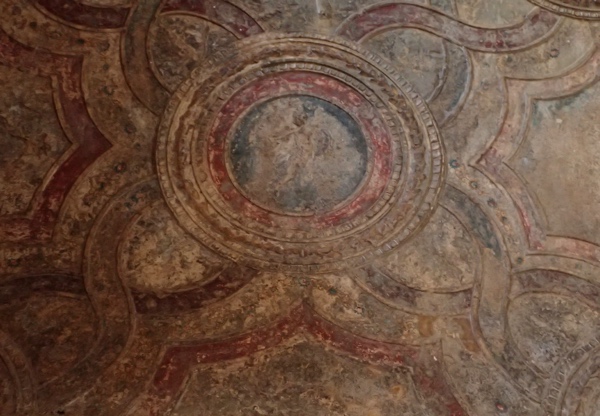 This room is the frigidarium for this bath house. It was for men only. People used the bath houses much like a steam, a hot bath and then a cold plunge at the end to refresh the body and close the pores of the skin… however, it was felt women didn’t have a strong enough constitution for such things, so they were not permitted to use the frigidarium room. The frigidarium roof:
This room is the frigidarium for this bath house. It was for men only. People used the bath houses much like a steam, a hot bath and then a cold plunge at the end to refresh the body and close the pores of the skin… however, it was felt women didn’t have a strong enough constitution for such things, so they were not permitted to use the frigidarium room. The frigidarium roof:
 The walls of the frigidarium:
The walls of the frigidarium: And the pool of the frigidarium:
And the pool of the frigidarium: The other ares of the bath house were two hot bath house room – one tepid, one really hot…
The other ares of the bath house were two hot bath house room – one tepid, one really hot…

 Back outside in the main square of Pompeii with Mt Vesuvius in the background.
Back outside in the main square of Pompeii with Mt Vesuvius in the background.
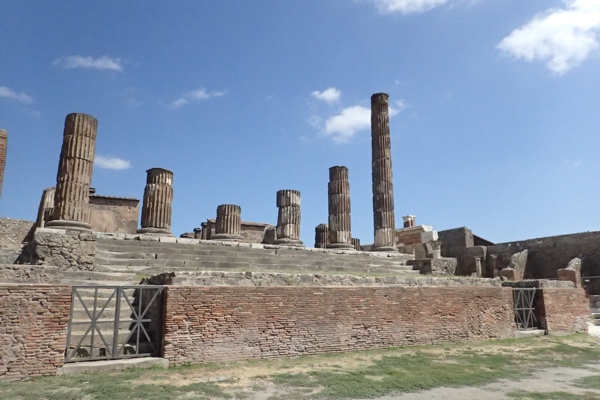 Along the left of the square is a large ‘warehouse’ that is open to the elements. It houses many of the ancient artefacts that won’t fit in the Napoli Archeological Pompeii Museum! All these items are authentic Roman artefacts found in Pompeii. Tables, jars and amphorae that held olive oil, wine, that weird fishy paste/sauce (garram? arum?) that Romans were fond of.
Along the left of the square is a large ‘warehouse’ that is open to the elements. It houses many of the ancient artefacts that won’t fit in the Napoli Archeological Pompeii Museum! All these items are authentic Roman artefacts found in Pompeii. Tables, jars and amphorae that held olive oil, wine, that weird fishy paste/sauce (garram? arum?) that Romans were fond of.

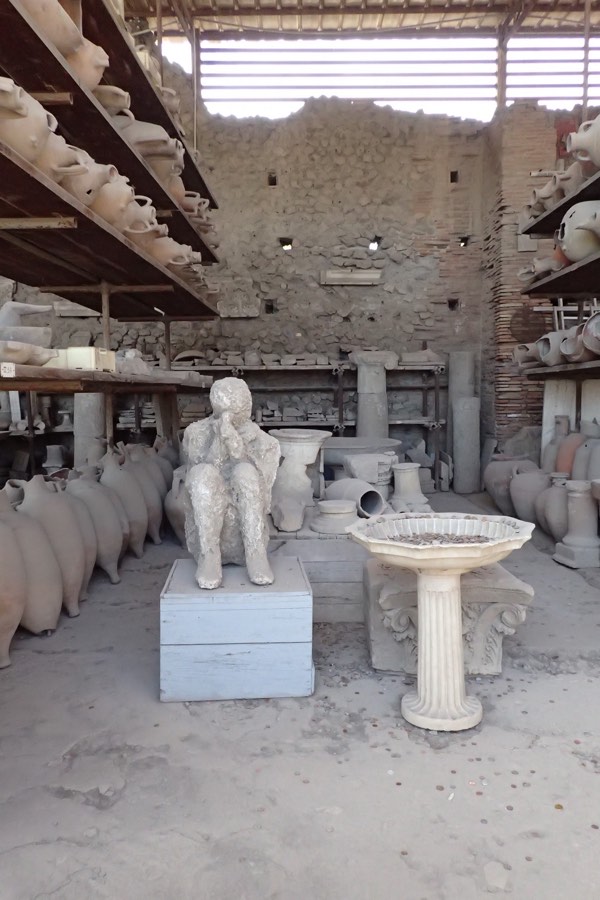 During the excavations of Pompeii, a particularly cluey archeologist discovered that they were unearthing ‘bubbles’ or cavities in the ash that occasionally had human remains in them. These cavities turned out to be where humans had been caught in the ash and had died, and subsequently decomposed. The archeologist (whose name I can’t remember) decided to pour plaster paris into the cavities to see what they were and discovered people, frozen at the time of their deaths. Most of these casts are now in the museum and are being tested for DNA to find out more about the people who died in Pompeii.
During the excavations of Pompeii, a particularly cluey archeologist discovered that they were unearthing ‘bubbles’ or cavities in the ash that occasionally had human remains in them. These cavities turned out to be where humans had been caught in the ash and had died, and subsequently decomposed. The archeologist (whose name I can’t remember) decided to pour plaster paris into the cavities to see what they were and discovered people, frozen at the time of their deaths. Most of these casts are now in the museum and are being tested for DNA to find out more about the people who died in Pompeii. And then it seemed we were leaving our tour. With a few of us having been here before, we asked the guide if we were going to the red light district, as attitudes to life, love, sex, and death were very different in ancient times and it’s interesting to see how the Romans’ views differed from our modern views. Our guide, Monica, claims was told by her company that we were not going to the brothels as part of our tour of Pompeii. We asked amongst ourselves and none of us had give that directive, so it seem she had taken it upon herself to censor our tour, possibly because we had four teenagers travelling with us. So suddenly we didn’t have time to go to the brothels at all. Bit disappointed for the others, but having been through them before, I was not too bothered. She did walk us back down a street we had already taken to show us a sign that pointed to the red light district (can’t believe we walked right past it and she didn’t point it out… bit prudish).
And then it seemed we were leaving our tour. With a few of us having been here before, we asked the guide if we were going to the red light district, as attitudes to life, love, sex, and death were very different in ancient times and it’s interesting to see how the Romans’ views differed from our modern views. Our guide, Monica, claims was told by her company that we were not going to the brothels as part of our tour of Pompeii. We asked amongst ourselves and none of us had give that directive, so it seem she had taken it upon herself to censor our tour, possibly because we had four teenagers travelling with us. So suddenly we didn’t have time to go to the brothels at all. Bit disappointed for the others, but having been through them before, I was not too bothered. She did walk us back down a street we had already taken to show us a sign that pointed to the red light district (can’t believe we walked right past it and she didn’t point it out… bit prudish). 
All up a great visit to Pompeii, (and I keep saying this when I travel) and I’d love to go back again even, so long as it wasn’t so hot! Stuff this travelling in the high season.

